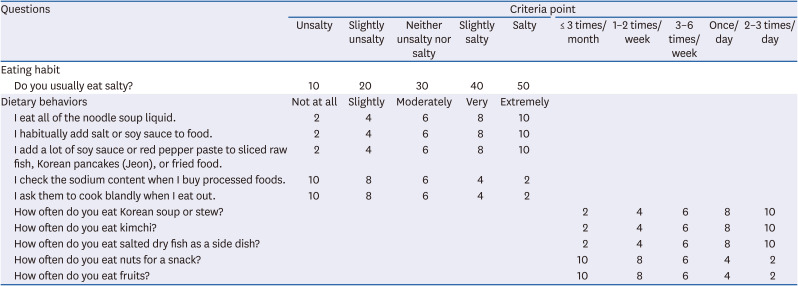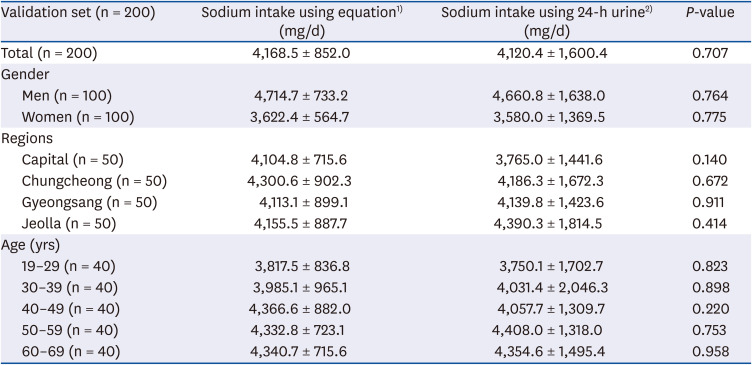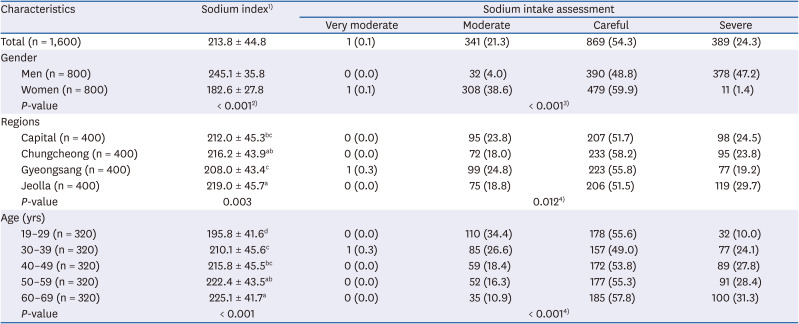1. He FJ, MacGregor GA. A comprehensive review on salt and health and current experience of worldwide salt reduction programmes. J Hum Hypertens. 2009; 23:363–384. PMID:
19110538.
2. Cook NR, Cutler JA, Obarzanek E, Buring JE, Rexrode KM, Kumanyika SK, Appel LJ, Whelton PK. Long term effects of dietary sodium reduction on cardiovascular disease outcomes: observational follow-up of the trials of hypertension prevention (TOHP). BMJ. 2007; 334:885–888. PMID:
17449506.
3. Asaria P, Chisholm D, Mathers C, Ezzati M, Beaglehole R. Chronic disease prevention: health effects and financial costs of strategies to reduce salt intake and control tobacco use. Lancet. 2007; 370:2044–2053. PMID:
18063027.
4. Tsugane S. Salt, salted food intake, and risk of gastric cancer: epidemiologic evidence. Cancer Sci. 2005; 96:1–6. PMID:
15649247.
5. Wong MM, Arcand JA, Leung AA, Raj TS, Trieu K, Santos JL, Campbell NR. The science of salt: a regularly updated systematic review of salt and health outcomes (August to November 2015). J Clin Hypertens (Greenwich). 2016; 18:1054–1062. PMID:
27461996.
6. World Health Organization. WHO Global Action Plan for the Prevention and Control of Noncommunicable Diseases 2013–2020. Geneva: WHO;2013.
7. Jung J. Policy trends of sodium reduction. Food Sci Ind. 2016; 49:2–7.
8. The Korean Nutrition Society. 2015 Dietary Reference Intakes for Koreans. Sejong: Ministry of Health and Welfare (KR);2015.
9. The Korean Nutrition Society. 2020 Dietary Reference Intakes for Koreans. Sejong: Ministry of Health and Welfare (KR);2020.
10. Ministry of Health and Welfare (KR). Korea Centers for Disease Control and Prevention. Korea Health Statistics 2019: Korea National Health and Nutrition Examination Survey (KNHANES VIII-1). Cheongju: Korea Centers for Disease Control and Prevention;2020.
11. Elliot P, Brown I. Sodium Intakes around the World. Geneva: WHO;2006.
12. World Health Organization. Reducing Salt Intake in Populations: Report of a WHO Forum and Technical Meeting. Geneva: WHO;2007.
13. Kawasaki T, Itoh K, Uezono K, Sasaki H. A simple method for estimating 24 h urinary sodium and potassium excretion from second morning voiding urine specimen in adults. Clin Exp Pharmacol Physiol. 1993; 20:7–14. PMID:
8432042.
14. Tanaka T, Okamura T, Miura K, Kadowaki T, Ueshima H, Nakagawa H, Hashimoto T. A simple method to estimate populational 24-h urinary sodium and potassium excretion using a casual urine specimen. J Hum Hypertens. 2002; 16:97–103. PMID:
11850766.
15. Brown IJ, Dyer AR, Chan Q, Cogswell ME, Ueshima H, Stamler J, Elliott P. INTERSALT co-operative research group estimating 24-h urinary sodium excretion from casual urinary sodium concentrations in western populations: the INTERSALT study. Am J Epidemiol. 2013; 177:1180–1192. PMID:
23673246.
16. Rhee MY, Kim JH, Shin SJ, Gu N, Nah DY, Hong KS, Cho EJ, Sung KC. Estimation of 24-hour urinary sodium excretion using spot urine samples. Nutrients. 2014; 6:2360–2375. PMID:
24955740.
17. Kong JS, Lee YK, Kim MK, Choi MK, Heo YR, Hyun T, Kim SM, Lyu ES, Oh SY, Park HR, Rhee MY, Ro HK, Song MK. Estimation model for habitual 24-hour urinary-sodium excretion using simple questionnaires from normotensive Koreans. PLoS One. 2018; 13:e0192588. PMID:
29447201.
18. Simko MD, Cowell C, Gilbride JA. Nutrition Assessment: A Comprehensive Guide for Planning Intervention. Silver Spring (MD): ASPEN;1995.
19. Holbrook JT, Patterson KY, Bodner JE, Douglas LW, Veillon C, Kelsay JL, Mertz W, Smith JC Jr. Sodium and potassium intake and balance in adults consuming self-selected diets. Am J Clin Nutr. 1984; 40:786–793. PMID:
6486085.
20. Rhodes DG, Murayi T, Clemens JC, Baer DJ, Sebastian RS, Moshfegh AJ. The USDA Automated Multiple-Pass Method accurately assesses population sodium intakes. Am J Clin Nutr. 2013; 97:958–964. PMID:
23553153.
21. Allès B, Samieri C, Lorrain S, Jutand MA, Carmichael PH, Shatenstein B, Gaudreau P, Payette H, Laurin D, Barberger-Gateau P. Nutrient patterns and their food sources in older persons from France and Quebec: dietary and lifestyle characteristics. Nutrients. 2016; 8:225. PMID:
27104557.
22. Bland JM, Altman DG. Statistical methods for assessing agreement between two methods of clinical measurement. Lancet. 1986; 1:307–310. PMID:
2868172.
23. Rhee MY, Kim JH, Shin SJ, Gu N, Nah DY, Park JH, Kim SW, Kim HJ, Oh KW, Kim JH, et al. Estimating 24-hour urine sodium from multiple spot urine samples. J Clin Hypertens (Greenwich). 2017; 19:431–438. PMID:
27735123.
24. Seong TJ. Validity and Reliability. Seoul: Hakjisa;1995.
25. Ji C, Miller MA, Venezia A, Strazzullo P, Cappuccio FP. Comparisons of spot vs 24-h urine samples for estimating population salt intake: validation study in two independent samples of adults in Britain and Italy. Nutr Metab Cardiovasc Dis. 2014; 24:140–147. PMID:
24119990.
26. Son SM, Huh GY, Hong SL. Development and evaluation of validity of dish frequency questionnaire (DFQ) and short DFQ using Na index for estimation of habitual sodium intake. Korean J Community Nutr. 2005; 10:677–692.
27. Obuchowski NA. Determining sample size for ROC studies: What is reasonable for the expected difference in tests' ROC areas? Acad Radiol. 2003; 10:1327–1328. PMID:
14626309.
28. Han BR, Bae HS. Development and evaluation of the semi-quantitative food frequency questionnaire to assess folate intake in women of child-bearing age. Korean J Community Nutr. 2012; 17:156–166.
29. Uechi K, Asakura K, Ri Y, Masayasu S, Sasaki S. Advantage of multiple spot urine collections for estimating daily sodium excretion: comparison with two 24-h urine collections as reference. J Hypertens. 2016; 34:204–214. PMID:
26599218.
30. Allen NB, Zhao L, Loria CM, Van Horn L, Wang CY, Pfeiffer CM, Cogswell ME, Wright J, Liu K. The validity of predictive equations to estimate 24-hour sodium excretion The MESA and CARDIA urinary sodium study. Am J Epidemiol. 2017; 186:149–159. PMID:
28838062.
31. Park YH, Chung SJ. A comparison of sources of sodium and potassium intake by gender, age and regions in Koreans: Korea National Health and Nutrition Examination Survey (KNHANES) 2010–2012. Korean J Community Nutr. 2016; 21:558–573.
32. Kang MJ, Choi KB, Lyu ES. Differences in sodium-intake related dietary behaviors and correlation analysis according to salty taste preference of university students in Busan area. Korean J Food Cookery Sci. 2015; 31:477–484.
33. He FJ, Marrero NM, MacGregor GA. Salt intake is related to soft drink consumption in children and adolescents: a link to obesity? Hypertension. 2008; 51:629–634. PMID:
18287345.
34. Kim HH, Lee YK. Analysis of presumed sodium intake of office workers using 24-hour urine analysis and correlation matrix between variables. Korean J Nutr. 2013; 46:26–33.
35. Jeong YS, Lim HJ, Kim SB, Kim HJ, Son SM. Blood pressure and dietary related risk factors associated with high sodium intake assessed with 24-hour urine analysis for Korean adults. Korean J Community Nutr. 2014; 19:537–549.














 PDF
PDF Citation
Citation Print
Print



 XML Download
XML Download